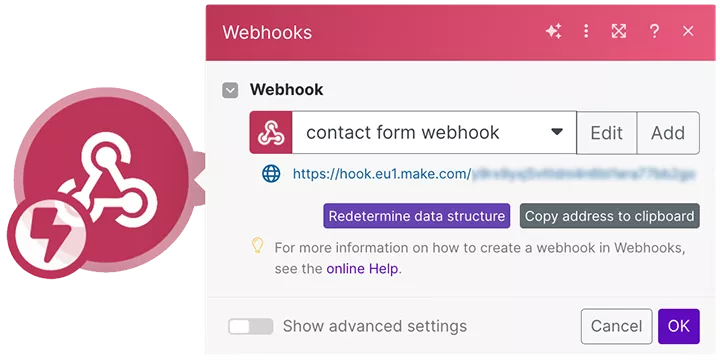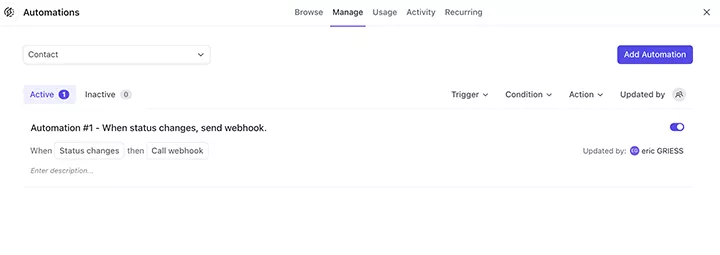In today’s fast-paced business world, automating customer interactions can save you time and resources. This tutorial will guide you through creating an AI-powered system that handles contact form submissions, filters out spam, and generates intelligent responses. Let’s dive in!
Requirements
Before we start, make sure you have the following:
- Make.com account
- ClickUp account with automation capabilities
- OpenAI Assistant API access
Step 1: Create AI Assistants
We’ll begin by setting up two AI assistants using OpenAI’s API: a spam filter and a contact agent.
Spam Assistant Setup
- Log into your OpenAI account
- Navigate to the Assistants section
- Click “Create New Assistant”
- Set the following:
- Name: Spam Filter
- Model: GPT-3.5 Turbo
- Enable “Return JSON”

Instructions:
Role: Your task is to analyze email content to determine if it is spam. You will receive the subject and body of an email and must return a JSON object indicating whether the email is spam. Spam includes common spam indicators as well as most cold outreach emails, excluding legitimate potential leads.
Input Format:
json
{
"subject": "string",
"body": "string"
}
Output Format:
json
{
"is_spam": true/false
}
Criteria for Identifying Spam:
Common Spam Indicators:
Phrases or keywords such as "win", "free", "prize", "congratulations", "urgent", "immediate response needed", "click here", "claim", "act now", "selected", "money", "offer", "risk-free".
Requests for personal or financial information.
Suspicious links or attachments.
Poor grammar and spelling errors.
Urgent calls to action.
Cold Outreach Emails:
Emails from companies selling services.
Emails with diverse cold approaches that are not from legitimate potential leads.
Instructions:
Receive Input: The assistant will receive a JSON object with subject and body fields.
Analyze Content: Check for common spam indicators and cold outreach emails.
Return Output: Respond with a JSON object containing a boolean is_spam field. Return true if the email is identified as spam, otherwise return false.
Example Input:
json
{
"subject": "Win a free iPhone now!",
"body": "Congratulations! You've been selected to win a free iPhone. Click here to claim your prize."
}
Example Output:
json
{
"is_spam": true
}
Example Input:
json
{
"subject": "Business Proposal",
"body": "Dear Sir/Madam, we would like to offer our services to improve your business. Please contact us for more details."
}
Example Output:
json
{
"is_spam": true
}
Example Input:
json
{
"subject": "Meeting Request",
"body": "Hi, I would like to discuss a potential partnership with your company. Could we schedule a meeting next week?"
}
Example Output:
json
{
"is_spam": false
}Test your spam assistant in the playground to ensure it correctly flags spam messages.
Contact Agent Setup
Follow the same steps as above, but with these changes:
- Name: Contact Agent
- Disable “Return JSON”
Instructions:
Role: You are an AI sales assistant specializing in {your domain}. Your task is to analyze and respond to inquiries from a contact form, providing helpful information about {your company name} services and encouraging potential leads to book a free call for further discussion when appropriate.
Input Format:
{
"subject": "string",
"body": "string"
}
Output Format:
A single string containing your response.
Instructions:
1. Receive Input: You will receive a JSON object with subject and body fields from the contact form.
2. Analyze Content: Determine if the inquiry is related to {your domain} or {your company name} services.
3. Generate Response:
- If the inquiry is relevant to {your domain}:
a. Provide a helpful, informative response based on {your company name} knowledge base.
b. Include specific benefits or solutions that {your company name} offers.
c. Encourage booking a free call for more detailed discussion.
- If the inquiry is not related to {your domain}:
a. Politely inform that you can only assist with {your domain}-related questions.
b. Suggest booking a call for further assistance if appropriate.
4. Return Output: Respond with a single string containing your generated response.
Criteria for Responses:
1. Always maintain a professional and helpful tone.
2. Provide specific information about {your company name} services when relevant.
3. Highlight the benefits of {your domain} for businesses.
4. Encourage booking a free call for more in-depth discussions when appropriate.
5. Keep responses concise but informative.
6. For unrelated inquiries, be polite but firm in redirecting to {your domain} topics.
Example Input:
{
"subject": "{Your domain} Inquiry",
"body": "Hello, I'm interested in learning more about how {your domain} can improve our business processes. Can you provide some information?"
}
Example Output:
"Thank you for your interest in {your domain} for your business processes! {Your company name} offers cutting-edge solutions that can significantly improve your efficiency. Our {specific product or service} can {describe main benefit}, freeing up your team for more {important tasks}. This typically results in {list key benefits}. To discuss how we can tailor our solutions to your specific needs, I'd highly recommend booking a free consultation call with one of our {your domain} experts. Would you like me to arrange that for you?"
Example Input:
{
"subject": "Unrelated Service Inquiry",
"body": "Hi, do you offer {unrelated service}? We're looking for a provider in this area."
}
Example Output:
"Thank you for reaching out. I apologize, but I'm only able to assist you with {your domain}-related questions. While we don't directly offer {unrelated service}, we do provide solutions that can {describe how your domain might indirectly help with their inquiry}. If you'd like to explore how {your domain} can improve your business performance in this area, you're welcome to book a call with one of our experts for further assistance. Would you be interested in scheduling a call to discuss this?"
Remember to always prioritize providing value to potential clients and guiding them towards booking a call for more personalized assistance when it makes sense for their inquiry.Customizing Your AI Sales Assistant
To tailor this AI sales assistant to your specific business:
Replace {your domain} with your area of expertise (e.g., “cloud computing”, “digital marketing”, “financial services”).
Replace {your company name} with the name of your company.
In the example responses, replace the placeholder content with specifics about your products or services.
Adjust the criteria and response guidelines to match your company’s tone and sales approach.
Remember, the more specific and relevant you make these instructions, the more effective your AI sales assistant will be in handling inquiries and generating leads.
Step 2: Connect Contact Form to Make.com
- Install the CF7 Webhook plugin on your WordPress site
- In Make.com, create a new scenario
- Add a Webhook module and select “Custom webhook”
- Copy the generated webhook URL

- In WordPress, go to Settings → CF7 Webhooks
- Paste the webhook URL and save

Step 3: Set Up Make.com Scenario
Add Spam Filter Module
- In your Make.com scenario, add a new “GPT” module
- Select “Message an assistant”
- Choose your Spam Filter assistant
- In the User Message field, enter:
{
"subject": "{{1.Subject}}",
"body": "{{1.Message}}"
}
Add JSON Parser
- Add a “JSON” module after the Spam Filter
- Configure it to parse the response from the Spam Filter


Add Contact Agent Module
- Add another “GPT” module
- Select your Contact Agent assistant
- Use the same JSON structure for the User Message as before

Add Filter
- Between the JSON Parser and Contact Agent, add a “Filter” module
- Set the condition to only proceed if the message is not spam


Add ClickUp Task Creation
- Add a “ClickUp” module
- Select “Create a task”
- Map the fields from your contact form and AI responses to the appropriate ClickUp fields

Step 4: Set Up ClickUp
- Create a new list in ClickUp for contact form submissions
- Add custom fields:
- Message (Text)
- Name (Text)
- Subject (Text)
- Generated Answer (Text)
- Received on (Date)
- Status (Status: In Review, Complete)

Step 5: Create ClickUp Automation
- In ClickUp, go to Automations
- Create a new automation:

- Trigger: When status changes from “In Review” to “Complete”
- Action: Send email
- Connect your email provider (e.g., Gmail)
- Configure the email template using ClickUp’s variable system to include the generated response

Testing and Going Live
- Save all your Make.com and ClickUp configurations
- Run a test submission through your contact form
- Check each step of the process:
- Data received in Make.com
- Spam filtering
- Response generation
- Task creation in ClickUp
- Manual review and status change
- Automated email sent to the contact

Congratulations! You’ve now set up an AI-powered contact form automation system. This setup will handle 90% of the work for you, filtering spam, generating initial responses, and organizing inquiries in ClickUp for easy management.
Remember to monitor the system regularly and fine-tune your AI assistants as needed to improve performance over time.
You can download the blueprint of this AI automation for free I’m happy to share it with you.